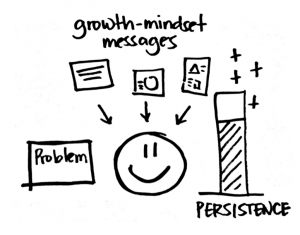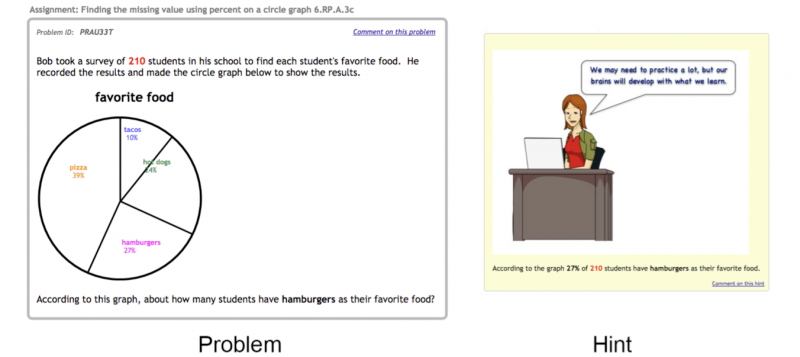Reinforce the Growth Mindset
| Reinforce the Growth Mindset | |
| Contributors | Paul Salvador Inventado, Peter Scupelli |
|---|---|
| Last modification | June 6, 2017 |
| Source | Inventado and Scupelli (in press 2016).[1] |
| Pattern formats | OPR Alexandrian |
| Usability | |
| Learning domain | |
| Stakeholders | |
Present feedback with motivational messages to remind students that they are capable of learning skills despite difficulties they may experience while learning.
Context
Students are asked to answer math problems on an online learning system to help them understand a topic they recently learned.
Problem
Students with a fixed mindset often give up when they struggle to solve a problem.
Forces
- Lack of persistence. Students may give up when they are unable to solve problems after a few attempts.
- Learned helplessness. Students who repeatedly fail to solve similar types of problems may believe that they will be unable to solve the same or similar problem in the future.
- Fixed mindset. Students who believe that their intelligence is innate and will not improve regardless of what they do are less likely to persist.
Solution
Therefore, provide students with motivational messages that promote the growth mindset when they fail to answer a problem. Students with a growth mindset believe that they can acquire skills as long as they invest time and effort to learn it, while fixed-mindset students do not. Motivational messages that promote the growth mindset may help change the way fixed-mindset students think about their intelligence and encourage them to persist. Some examples of motivational messages may be: “Did you know that when we learn something new our brain actually changes? It forms new connections inside that help us solve problems in the future. Pretty amazing, huh?”, “I think that more important than getting the problem right is putting in the effort and keeping in mind the fact that we can all be good at math if we try.”, and “When we realize we don’t know why that was not the right answer, it helps us understand better what we need to practice.”[2]. Motivational messages may be shown with explanatory feedback when students struggle to solve a problem so they remember why it is important to persist. Motivational messages may be presented in different ways such as textual messages, audio messages, videos, or animated pedagogical agents. Avoid overusing motivational messages so students do not get bored or annoyed by it. For example, show messages only when the student submits an incorrect answer on the second attempt and only in every other Math problem.
Consequences
Benefits
- Motivational messages can encourage students to devote more time and effort that can help them solve the problem.
- Students’ self-efficacy and confidence may improve when they receive motivational feedback, decide to persist in solving difficult problems, and eventually answer problems correctly
- Motivational messages can help students change the way they think about their own intelligence especially after they experience the benefits of persistence.
Liabilities
- Some students may get annoyed after getting too many motivational messages especially if they sound repetitive.
- Persistent or motivated students may get distracted from unnecessary motivational messages.
- Motivational messages may not be very effective if students have not developed a certain level of “rapport” with the system.
Evidence
Literature
- According to Dweck[3], students often approach learning tasks with a fixed or growth mindset. On one hand, students with a fixed mindset believe that their intelligence is innate and additional effort or practice will not improve it. Students with a growth mindset on the other hand believe that devoting time and effort to learn can help them improve or acquire new skills.
- Students who struggle with learning activities are more likely to benefit from motivational messages[2].
- Students’ mindset may be altered using different strategies such as praising processes that lead to success, sharing articles and studies about the growth mindset, or contextualizing the growth mindset in the current learning situation[4][5][6].
Related patterns
The Reinforce the Growth Mindset design pattern can be used when students are asked to practice skills they learned such as what is described in the Try It Yourself design pattern[7]. It can be used with the Build and Maintain Confidence design pattern[7] to encourage students to persist despite experiencing learning difficulties. The pattern can also be used to provide positive reinforcing comments in the Feedback Sandwich design pattern[7]not only to encourage students, but also to emphasize that persistence helps them learn better.
Example
Several research used growth-mindset interventions to help various student populations such as high school students, community college students, charter school students, and students from large institutions[8]. In one study, students read an article about the brain’s ability to restructure itself with continued effort and applying better strategies to promote the growth mindset. The activity was reinforced by asking students to summarize the article and to give advise to a hypothetical student who thought he was not smart enough. The impact of the results might have varied, but generally students benefitted from the intervention.
More recently, motivational messages were used to support students learning math in the ASSISTments online learning system. Experimental results suggested performance improvements in students struggling with math problems who received motivational messages[2].
The following figure illustrates an example of a motivational message shown by the ASSISTments online learning system. A pedagogical agent conveys the motivational message when students request hints to help them solve a problem. Specifically, the agent says, “We may need to practice a lot, but our brains will develop with what we learn.”
References
- ↑ Inventado, P.S. & Scupelli, P. (in press 2016). Patterns for Learning-Support Design in Math Online Learning Systems. In Proceedings of the 23rd Pattern Languages of Programs (PLoP 2016). New York:ACM.
- ↑ 2.0 2.1 2.2 Ostrow, K. S., Schultz, S. E. & Arroyo, I. (2014). Promoting growth mindset within intelligent tutoring systems. In Sergio Gutiérrez Santos, Olga C. Santos (Eds.), Proceedings of the Workshops on The Non-Cognitive Factors and Personalization for Adaptive Learning (NCFPAL) held at Educational Data Mining 2014, London, United Kingdom, July 4-7, 2014.
- ↑ Dweck, C.S. (2006). Mindset: The new psychology of success. Random House.
- ↑ Cimpian, A., Arce, H. M. C., Markman, E. M., & Dweck, C. S. (2007). Subtle linguistic cues affect children's motivation. Psychological Science, 18(4), 314-316.
- ↑ Dweck, C. S. (2007). The perils and promises of praise. ASCD, 65(2), 34-39.
- ↑ Yeager, D. S., & Dweck, C. S. (2012). Mindsets that promote resilience: When students believe that personal characteristics can be developed. Educational Psychologist, 47(4), 302-314.
- ↑ 7.0 7.1 7.2 Bergin, J., Eckstein, J., Völter, M., Sipos, M., Wallingford, E., Marquardt, K., Chandler, J., Sharp, H., and Manns, M.L. (2012). Pedagogical patterns: advice for educators. Joseph Bergin Software Tools.
- ↑ Yeager, D. S., Paunesku, D., Walton, G. M., & Dweck, C. S. (2013, May). How can we instill productive mindsets at scale? A review of the evidence and an initial R&D agenda. In white paper prepared for the White House meeting on “Excellence in Education: The Importance of Academic Mindsets,” available at https://labs.la.utexas.edu/adrg/files/2013/12/Yeager-et-al-RD-agenda-6-10-131.pdf.

